So, you’ve started a blog and now what??
You’re probably thinking to yourself…
When exactly does it become a business?
Monetizing a blog and turning it into a business is not exactly done overnight, especially when you consider the stages of business.
There’s a gradual procession.
Kind of like how you don’t get a high school diploma after kindergarten. There are a bunch of grades in between.
In this article, I’m going to show you:
- 5 stages of the business life cycle
- 6 stages of business success
- The Boston Matrix and how it relates to business stages
Let’s get started!
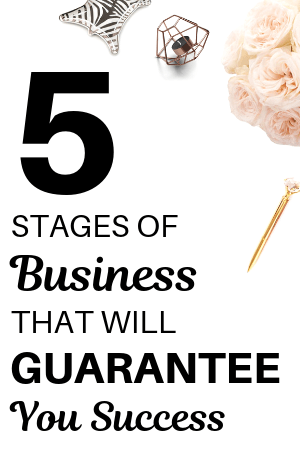
5 Stages of the Business Life Cycle
Your business isn’t a cat, so it doesn’t have nine lives, but it does have a life cycle.
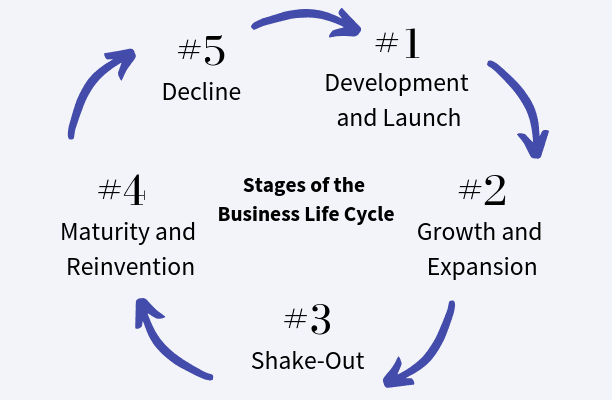
The business life cycle is defined by these five stages:
- Development and Launch
- Growth and Expansion
- Shake-Out
- Maturity and Reinvention
- Decline
Let’s dive into these stages of business a little more!
1. Development and Launch
Do you remember that moment when you decided to start your blogging business?
You were probably guilty of browsing a little too much on Pinterest one night after work and came across an article telling you of how you could make A LOT of money with a blog.
I’m right there with you (except mine was a YouTube video).
Suddenly…
All these ideas start popping into your head.
You want to start a blog on:
- Personal finance
- Parenting
- DIY
- Etc.
At this point, all the ideas are developing right in front of you, so you flesh them out for critique in a blogging Facebook group.
After you’ve found your niche (for now), you go to launch it.
You start a WordPress blog because they’re the best and pick a glitzy theme to showcase your amazing story.
Then, you make an announcement to the world (and to the search engines) that your blog has been launched.
This is the first stage of the business life cycle.
To get there, you conceptualized your business and took the action necessary to render it into something tangible.
2. Growth and Expansion
So, now you have a business!
Congratulations!
You want to start making money from this business, so you go on Pinterest to try and get some traffic. You also try and optimize your posts for Google, but you know that takes longer.
In this stage, you’re taking action to grow your newly founded business.
You’ll get stuck in this stage for quite some time. Just an FYI.
It won’t be easy and you may even think of stopping blogging altogether, but you push your way through the chaos and FINALLY start to see your revenue coming in.
Then, you think to yourself about how you can grow your revenue even more.
You will stretch yourself thin during this period of expansion and you’ll realize that you need to:
- Productize
- Document your processes
- Hire a team
- Scale your business
This is the exciting part! You’re finally gaining traction with your blogging business. If you’re lucky, you’ll stay in this stage forever and never advance to the next.
At this point, you also might want to think of an exit strategy. They have big payoffs.
You may have found that you want to blog about something else or that you’ve had enough of your business. You don’t need to sell, but some make a considerable profit selling blogs.
To get to this stage, you grew your business and expanded your offerings.
3. Shake-Out
Once you get to a certain stage in business, the going gets rough.
You have to stay super tough to remain in business.
You may find your bottom line (the profit) beginning to go below the money you’re spending to keep the business afloat.
This right here is why a lot of small businesses fail.
Other people emerge into your niche and suddenly, you’re not the only player.
You’re pushing for sales and you will peak in this stage. They’ll still increase, but at a MUCH slower rate than what they used to.
This may realistically happen if:
- Google or Pinterest drastically changes their algorithm and your search traffic plummets
- A major company acquires a smaller company in your space and begins stealing the customers
- Other companies have better technology and systems to do what you do better
This is a SCARY stage.
Think of The Penny Hoarder or Buzzfeed and how they recently laid off nearly half their stuff.
If you can survive this stage, then you may be able to reinvent yourself before you get left behind in the dust.
4. Maturity and Reinvention
You know some of those original gangsters of blogging? Or, even those you look up to that have been blogging for a few years?
I’m not going to name names, but you have probably already created a list in your head.
What happens to them is that they begin to lose traction. They’re kind of just coasting on past relationships and merits and sailing forward without really adjusting the sails.
Because they’ve become kind of corporate to attain the growth and expansion they had, they may be receiving external funding or drawing from cash reserves to keep their operations running.
Sales will begin to decrease and they approach a crossroads. Do they continue at their current pace or do they try and reinvent themselves?
Most companies will try and reinvent themselves over closing up shop.
They’ll:
- Create a new product
- Change up their website design
- Change their mission and vision
- Appeal to a different audience
This is their last-ditch effort at staying in business.
If they are SUCCESSFUL, then they will try and grow and expand that newly discovered business before there’s another shake-out.
So, they’ll repeat steps 2-4.
If they are UNSUCCESSFUL, then they will go on the decline and you’ll find their domain name expired, having moved on to other things.
To get to this business stage, they survived the shake-out and either matured on to decline or reinvented themselves.
5. Decline
When a business is on the decline, it’s kind of sad to watch.
You see a company standing in the shadow of its former glory.
At this stage, businesses:
- Accept their defeat
- Realize they no longer have a competitive advantage
- Exit the market
They may take what they learned from this business and reinvest the efforts into another.
This is SO common! Many successful bloggers and business owners have had failures before they found their successful concepts that don’t end up closing shop.
The biggest advice I can give you is to learn from your mistakes and try again.
Entrepreneurs simply aren’t subdued that quickly!
I bet it won’t take that long before you transition into the first stage and repeat the business life cycle.
To get to this business stage, you matured and/or failed to reinvent and then declined to the point of exiting the market and chalking it up to an unsuccessful venture.
Next, we’ll go over the stages of business success and how you can avoid this stage.
6 Stages of Business Success
Now that you have an understanding of the business lifestyle, I want to show you the phases of business success (also known as stages).
By implementing these into your business, you’ll come out on top and continue into a period of growth and expansion for a VERY long time.
When you look at successful bloggers and business owners, there’s an art to the process.
Things just don’t “get done.”

Right in front of you, I’m going to unfold that very 6-stage process for business success:
- Brainstorming
- Assessment
- Planning
- Development
- Testing
- Launch
Let’s explore these topics a little more!
1. Brainstorming
Before any thoughts are realized into a concept, brainstorming must occur.
Brainstorming, for me, is the MOST important stage out of all of them.
If you don’t come up with the right ideas, the rest of the process falls apart.
Launching a poorly envisioned product will lead to no sales.
Why?
You didn’t brainstorm properly. Don’t underestimate the length you have to brainstorm for to be successful. Come up with several ideas before you choose one.
Ideation is one of my favorite things to do.
In fact, it’s my #4 Clifton Strength. That means I’m pretty good at it 🙂
If you’re a tactile person, write your ideas on paper. If you’re a digital person, type it out on your phone or your computer. You could even use something like Evernote for this purpose.
DON’T erase or delete anything because you think it’s not good enough.
You’re going to assess its viability during the next stage, so just keep producing ideas.
This isn’t Planet Fitness, but it IS a no-judgment zone.
2. Assessment
This is the stage when you find out if your idea is a good idea or if it should be discarded.
Let’s imagine, for example, that you’re creating a product in the career advice space. You could totally apply this to areas other than product creation, but this is what my mind went to first.
(This was my former blog’s topic, so I spent a lot of time brainstorming and assessing future monetization avenues, even though I never got there.)
You may have ideas like:
- Resume workshops
- Interviewing lessons
- Public speaking worksheets
- And so forth
Here are a few ways to see if these ideas are viable and if you should pursue them:
- Do a search on Google to see if there are competitors already doing it
- Browse on Pinterest for pins relating to the topic
- Search YouTube for videos on what you want to discuss
If people ARE searching for these topics, then you should pursue them.
It’s actually a good idea to go with a concept that has already been successfully executed.
This is called proof of concept and it means that the concept works. It means you’ve assessed the topic and found there to be a significant enough market size for you to enter.
If it works for them, why shouldn’t it work for you, as well?
(Conceptually speaking. Set aside all the differences and just evaluate the facts. In economics, the term is called “ceteris paribus,” and it means everything else the same.)
3. Planning
Now that you’ve decided on your winning career advice product idea (continuing with the example, here), it’s time to plan and flesh out what that product looks like.
You may be thinking about things like:
- Names
- Branding
- Sales page
- Outline of the product
- Format
Organize your thoughts however you please and feel free to ask a few people close to you (or even your audience — they LOVE giving feedback) for constructive criticism.
It’s important when planning to think about your audience’s pain points.
Maybe they’ve expressed to you that they don’t know how to write a resume or that they don’t know how to format a resume. Those are two completely different concepts!
One is about copywriting and the other is design.
In your planning phase, make sure you plan based on your audience’s pain points and what they actually need help with.
If you solve the right problem, you’ll strike gold.
If you solve the wrong problem, you won’t strike much of anything.
At this point, some people may advise you to do what’s called a seed launch. They mean launch the current product (before you develop and test it) to gain money and a crew of BETA testers to guide you through the process.
You can totally choose to sell your ideas and develop and refine it later or choose to launch with a fully completed product.
If you don’t have an email audience that trusts you a lot, I’d recommend launching the full product.
To do that, you’ll need to develop it, which brings us to the next stage.
4. Development
Developing the product is when you get to geek out with your knowledge and create the best product there is out there.
You’re creating the copy, the graphics, the physical components of the product (workbook, eCourse, eBook, etc.), and the whole shebang.
While you’re in the development stage, FOCUS on developing the product or whatever you’re developing. Make this your priority until you are done with it.
If you aren’t focused, then it will take you much, much longer to finish this stage and you’ll never leave it.
Seriously, though.
Those who are perfectionists tend to have the biggest difficulty with this stage because they don’t want to advance past it until everything is perfect.
Don’t get wrapped up in that toxic mindset.
The BEST business owners find a solution that will get them 80% of the way there and then worry about the other 20% later. Worry about that after testing.
Whatever you do and however long this stage takes, come out with a drafted product that you can test.
And, that brings us to one of the last stages of business success: testing.
5. Testing
You could easily slap “BETA” in front of this stage’s name because it’s an apt description.
In this stage, you’re testing your product, concept, idea, etc.
You want to be very observant in this phase. This is not the time to speak up or defend why you did something in a specific way. Your product is now at the mercy of those that might purchase it.
Their feedback is crucially important.
To obtain feedback, there are a few ways:
- Have a Facebook group or forum
- Encourage communication by email
- Send out a survey
However you obtain feedback is irrelevant. The point is that you’ve got precious cargo aboard your ship now.
This is the information that you’ve been waiting for. Treat it with respect.
Take the data from your testing and revise the product.
If you completely missed the mark, you’ll want to revisit stages 2-4 again (this is why the seed launch exists and some do it — it tests viability before creation).
If you just have a few tweaks, great! Make the adjustments and prepare for launching, which will bring us to the last stage.
6. Launch
Go ahead, sing the Etta James classic.
AT LAST, you’re ready to launch.
This is when you put your Sunday best on, figuratively speaking, and get everything prepped and ready for launch.
You’re going to do things like:
- Brush up the copy on your sales page and format it gorgeously
- Prepare an email sequence to advertise to your audience
- Reach out to influencers to promote it
- Set up an affiliate program
And, then you launch! Pick a date and commit to it!
Let me know how it went in the comments below.
After you launch, you’ll repeat stages 3-6 with future iterations. Optimization is key!
This tends to be very cyclical, much like the stages of the business life cycle.
Once you have a product, I think it’s important to understand how it performs within your industry. Which leads us to a riveting discussion on the Boston Matrix.
The Boston Matrix and How it Relates to Business Stages
I’ve never seen the Boston Matrix discussed on a business blog for bloggers before, so I am happy to hopefully introduce you to it.
Essentially, it’s a matrix, so there are four categories:
- Question marks
- Stars
- Dogs
- Cash Cows
The x-axis (horizontal) is market share and the y-axis (vertical) is market growth.
This is a system that you can use to evaluate how your product sits in the market.
This is a tool originally developed by the Boston Consulting Group, so don’t ask me how they come up with the names for each quadrant. It’s also known as the Growth-Share Matrix.
But, here is a visual for you to look at before reading the breakdown of each one.
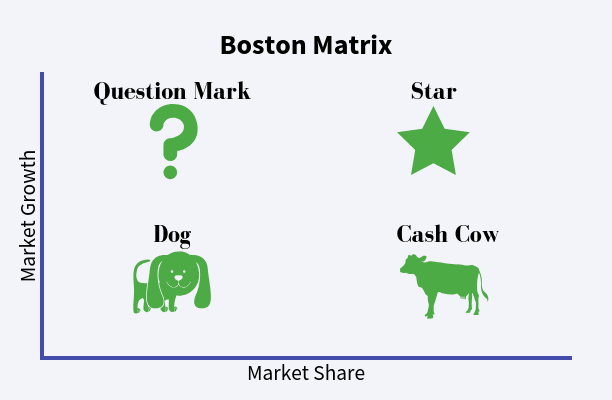
Now that I’ve stimulated your eyes, let’s dive into these a little further!
1. Question Marks
This is where there is a low market share and high market growth.
These are opportunities that could be a lot of fun, but you don’t know if the time and money will be worth the investment.
In other words, the ROI is questionable.
You may start out here and transition into a different quadrant after you test the waters.
2. Stars
This is what you should strive for!
Stars have high market share and high market growth.
This basically means that you’re well-established, you’re raking in the dough, and your market is rapidly increasing.
If your product is a star, you’ll be sitting pretty for some time.
But, don’t get too cocky or try and scale too fast just because your product is selling well. You may miss the warning signs before transitioning into a different quadrant.
3. Dogs
I really LOVE dogs and I want to get one (or two or three), so I don’t like talking about dogs negatively.
I digress…
In this matrix, dogs have low market share and low market growth.
This signifies that your presence in the industry is weak and that you probably won’t turn a profit.
It’s best to cut your losses here and try a different product.
Remember that it’s okay (and normal) to fail before you succeed.
4. Cash Cows
Cash cows are an interesting position to be in.
They have high market share, but the market growth is low.
This means that they’re making bank, but they have nowhere to grow in the current market and it’s not getting any larger.
But, while they’re in their heyday, it’s a really fun business to be a part of and the profits are insane.
If you’re sitting on a cash cow, think about repositioning it in a market that has more potential growth.
Conclusion
Did you make it all the way to the end?
Congratulations, if so!
In this article, we discussed:
- 5 stages of the business life cycle
- 6 stages of business success
- The Boston Matrix and how it relates to business stages
You should now have a great grasp and understanding on the business life cycle, the stages of business success, and the Boston Matrix.
Together, these combine into an unformidable business force that will bring your business guaranteed success (if you implement it properly).
Let me hear how you’re implementing these strategies in the comments below and if I missed anything.
Cheers to future success!

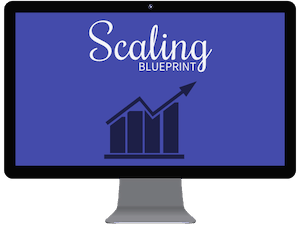


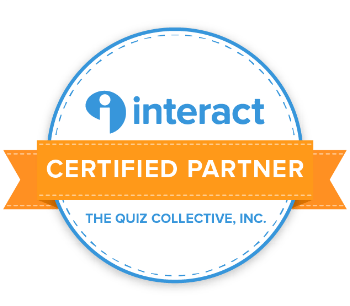
I’m in stage #2 of the business life cycle, and stages #3 and #4 combined for the success stage, but with affiliate marketing instead of my own product. I have partnered with a major player in my niche to promote their product through affiliate sales. Exciting times ahead!! …and A LOT of work, lol
Hey Cathy! Thanks for commenting with your progress 🙂 Glad to hear that you’re growing and expanding! Remember to not spend TOO long in the planning and developing stages. It’s often best to get something out there and see how it performs. Especially with affiliate funnels, which is a great way to implement this advice. You’ll need at least a hundred subscribers to go through your funnel to see if the offer converts. Did the company in your niche already have an affiliate program or did you convince them to start one? Yes, it is exciting and A LOT of… Read more »
Thanks, Drew! The company already had an affiliate program, but it’s less than a year old, and they just launched their course back in May of this year, with future courses/products in development. They do not advertise their affiliate program on their website, and it doesn’t come up in Google search, so it was only by emailing them directly that I learned about it.
Usually, the programs that aren’t advertised as heavily means that there aren’t as many affiliate partners. This gives you a great opportunity to write a well-optimized article for Google (see this interview with Mike Pearson for Google tips: https://drewduboff.com/mike-pearson) and hopefully earn some bank on affiliate commissions passively through organic search. Definitely have a review article to link to in your email funnel. Can’t wait to see how this turns out for you!
Awesome! Thanks for the tips!
You’re welcome!
Hey Drew! I wanted to say thanks on the advice to get a review article written right away on that new affiliate product. Because the product is so new, my article is already ranking on the first page of Google for several keyword searches. AND, I’ve already made 1 sell. Exciting times!
Cathy, this is SO awesome to hear! Google traffic is the bomb dot com for affiliate conversions 🙂